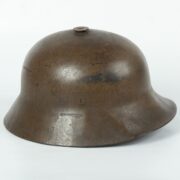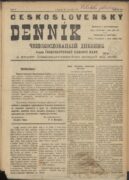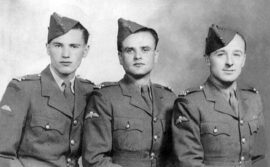
08 Austro-Hungarian Berndorf Type Helmet, 1917
Fotogalerie

In October 1916, the Berndorfer Metallenfabrik Artur Krupp A. G. Berndorf offered its own model of steel helmet to the High Command of the Army of the Austro-Hungarian Monarchy. At first glance, the shape of the new design differed somewhat from the M1916 German model. The bell plate was moulded from one piece; however, due to the lack of suitable engineering tools, the shape of the faceplate was somewhat less elegant. There was only one ventilation hole at the top of the helmet, covered by a small steel cap. This served, like the two ventilation holes of German helmets, to attach additional frontal armour. This headwear, designed to protect the wearing from direct fire with infantry weapons, was of a more elaborate design, with a canvas strap around the helmet. Soldiers in forward positions were provided with the armour only when on duty. They would leave it for the next shift when they finished. Some helmets came with canvas covers to prevent unwanted glare. A number of variants appeared in production, differing mainly in the types of inner lining. A characteristic feature of the Berndorf helmets was the felt insert under the lining, which made them more comfortable to wear. A. Krupp A. G. Berndorf produced almost 140,000 helmets between May and November 1917.
Aktuálně

Československý deník sehrál v životě legionářů v Rusku velmi důležitou roli. Poprvé vyšel v prosinci 1917

Děkujeme za podporu pro válečné veterány. Sbírka DiGiMÁK vynesla 450 tisíc korun

Tak trochu zamrzlé spojení

Válečný veterán Petr Matouš pokřtil v Armádním muzeu Žižkov svou knihu. Patronkou je i ministryně obrany Jana Černochová








